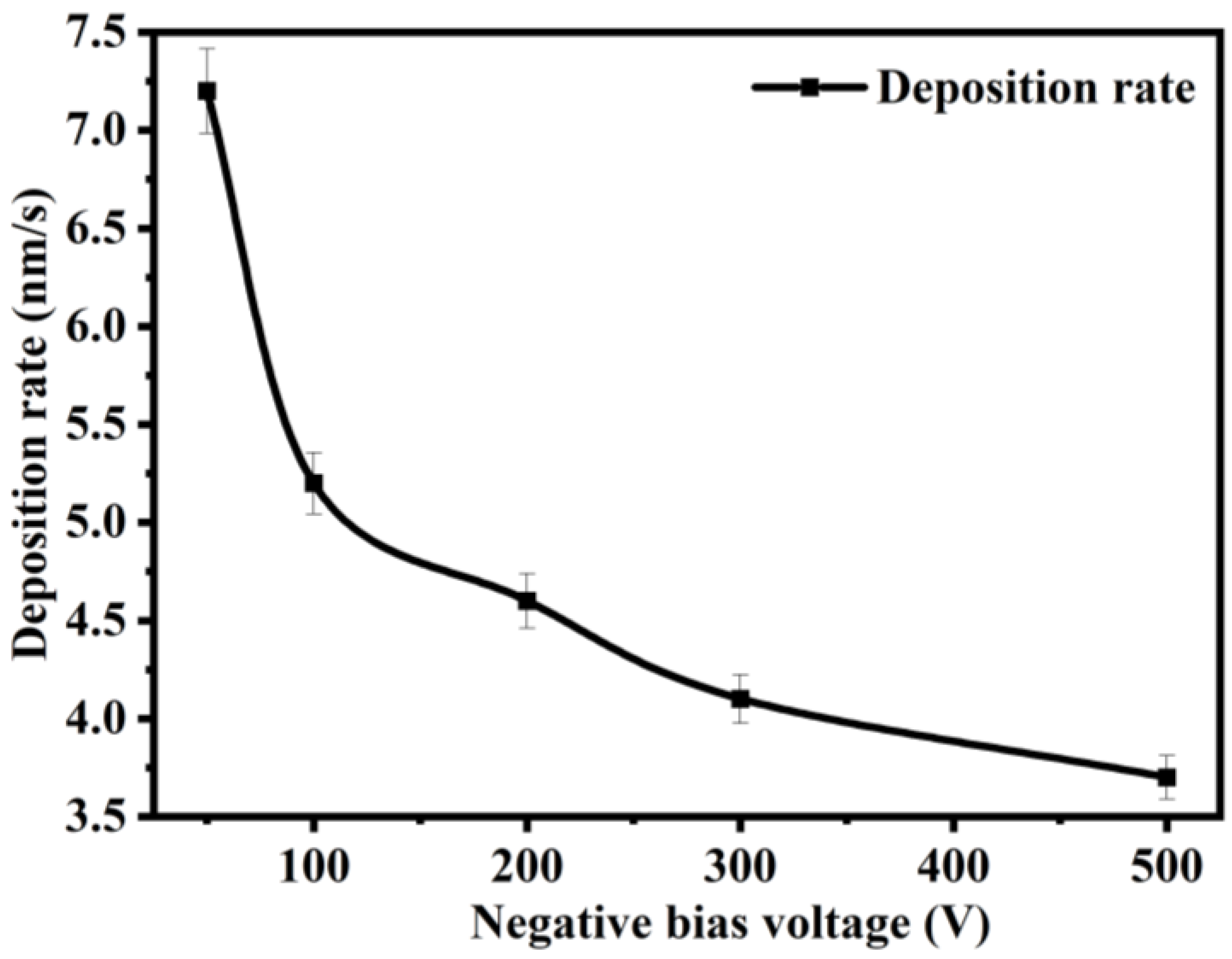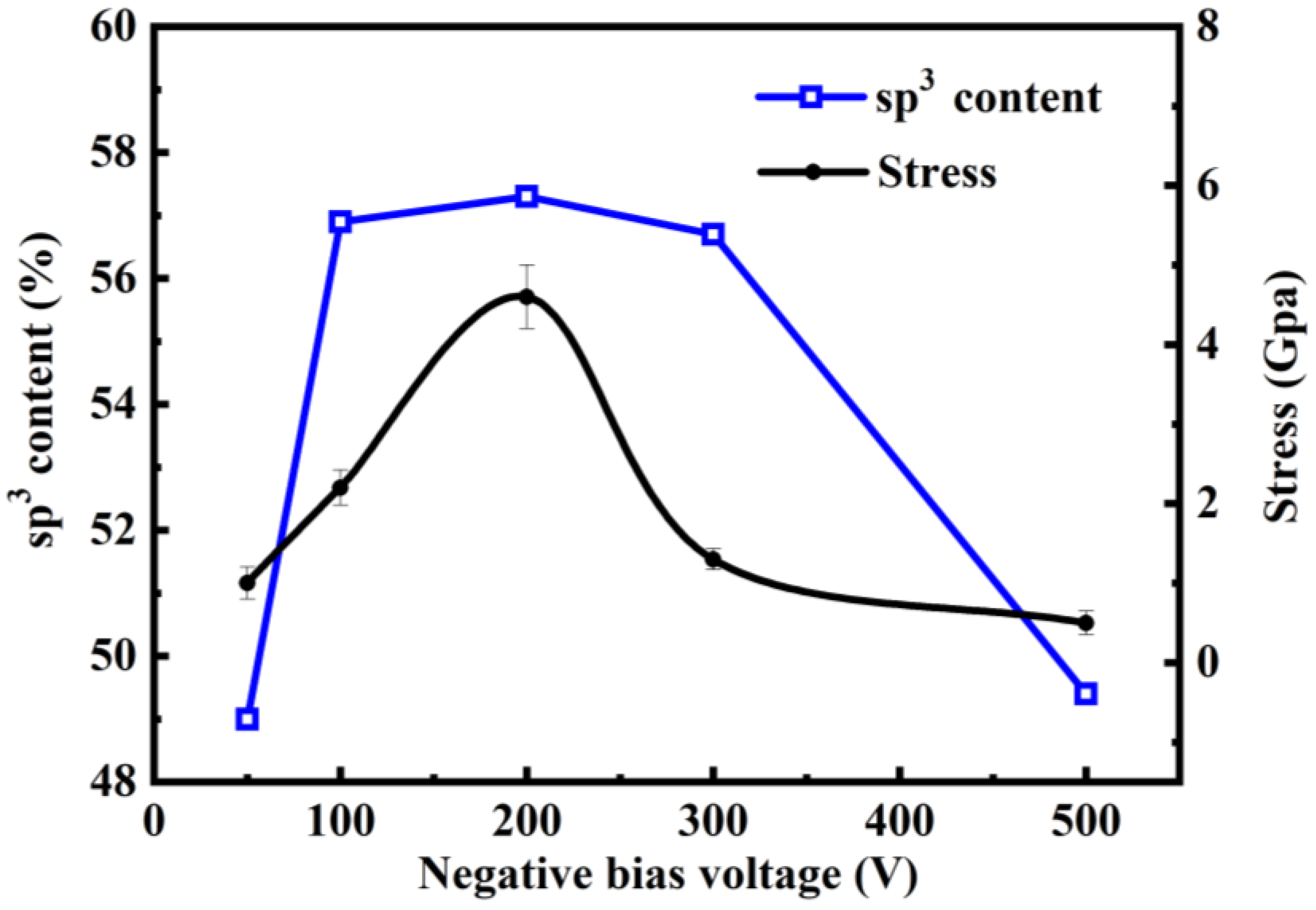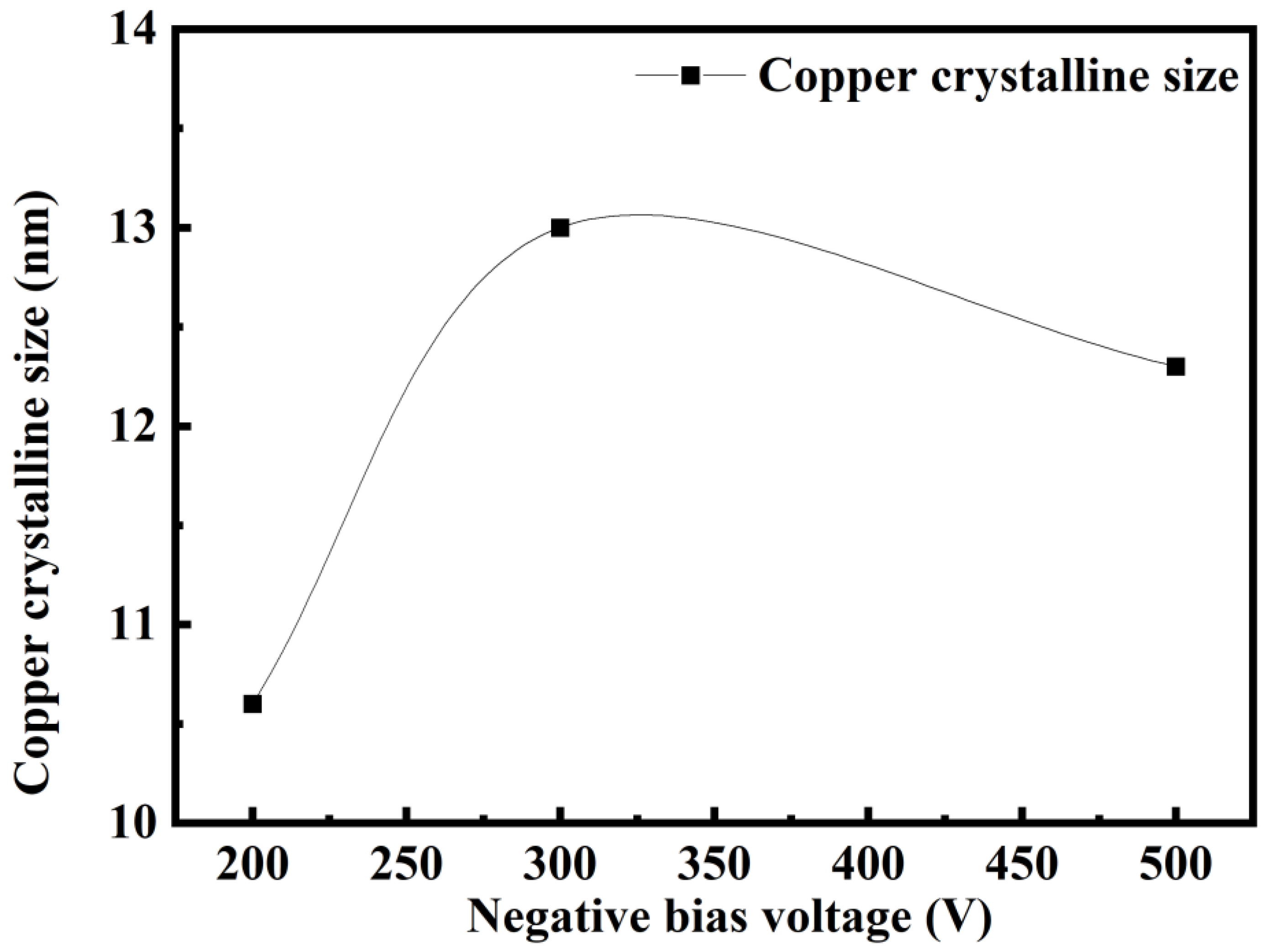Effect of Substrate Negative Bias on the Composition and Structure of nc-Cu/a-C:H Nanocomposite Films Deposited by FCVA
Abstract
1. Introduction
2. Experimental Details
2.1. Processing of Coatings
2.2. Analyzing Methods
3. Results and Discussion
3.1. Film Composition
3.2. Film Structure
4. Conclusions
Author Contributions
Funding
Institutional Review Board Statement
Informed Consent Statement
Data Availability Statement
Conflicts of Interest
References
- Cui, X.-J.; Ning, C.-M.; Shang, L.-L.; Zhang, G.-A.; Liu, X.-Q. Structure and Anticorrosion, Friction, and Wear Characteristics of Pure Diamond-Like Carbon (DLC), Cr-DLC, and Cr-H-DLC Films on AZ91D Mg Alloy. J. Mater. Eng. Perform. 2019, 28, 1213–1225. [Google Scholar] [CrossRef]
- Zeng, A.; Neto, V.F.; Gracio, J.J.; Fan, Q.H. Diamond-like carbon (DLC) films as electrochemical electrodes. Diamond Relat. Mater. 2014, 43, 12–22. [Google Scholar] [CrossRef]
- Komlenok, M.S.; Arutyunyan, N.R.; Kononenko, V.V.; Zavedeev, E.V.; Frolov, V.D.; Chouprik, A.A.; Baturin, A.S.; Scheibe, H.J.; Pimenov, S.M. Structure and friction properties of laser-patterned amorphous carbon films. Diamond Relat. Mater. 2016, 65, 69–74. [Google Scholar] [CrossRef]
- Hainsworth, S.V.; Uhure, N.J. Diamond like carbon coatings for tribology: Production techniques, characterisation methods and applications. Int. Mater. Rev. 2013, 52, 153–174. [Google Scholar] [CrossRef]
- Ajay, T.; Mugendiran, V.; Vasumathi, M.; Rashia Begum, S. Study of machining performance and tribological characteristics of monolayer, compound and bilayer Diamond-Like carbon (DLC) coated HSS drill bits. Mater. Today Proc. 2024, in press. [Google Scholar] [CrossRef]
- Xiao, J.; Xu, H.; Guo, A.; Wang, Y. Study on FN-DLC thinfiIms: (II) effect of radio frequency power on the optical band gap of the thin fiIms. Acta Phys. Sin. 2007, 56, 1809–1814. [Google Scholar] [CrossRef]
- Xiao, J.; Cao, X.; Jiang, A.; Ma, S.; Wang, Z. Design and preparation of FDLC/Ag/FDLC sandwich films with tunable photoelectric performance. Diamond Relat. Mater. 2020, 106, 107825. [Google Scholar] [CrossRef]
- Sheng, H.; Xiong, W.; Zheng, S.; Chen, C.; He, S.; Cheng, Q. Evaluation of the sp3/sp2 ratio of DLC films by RF-PECVD and its quantitative relationship with optical band gap. Carbon Lett. 2020, 31, 929–939. [Google Scholar] [CrossRef]
- Lin, Y.; Zia, A.W.; Zhou, Z.; Shum, P.W.; Li, K.Y. Development of diamond-like carbon (DLC) coatings with alternate soft and hard multilayer architecture for enhancing wear performance at high contact stress. Surf. Coat. Technol. 2017, 320, 7–12. [Google Scholar] [CrossRef]
- Liang, H.; Delian, L.; Xian, C.; Li, Y.; Yuqing, Z. The deposition of a thick tetrahedral amorphous carbon film by argon ion bombardment. Appl. Surf. Sci. 2012, 258, 4794–4800. [Google Scholar] [CrossRef]
- Lei, Y.; Jiang, J.; Wang, Y.; Bi, T.; Zhang, L. Structure evolution and stress transition in diamond-like carbon films by glancing angle deposition. Appl. Surf. Sci. 2019, 479, 12–19. [Google Scholar] [CrossRef]
- Ferrari, A.C.; Kleinsorge, B.; Morrison, N.A.; Hart, A.; Stolojan, V.; Robertson, J. Stress reduction and bond stability during thermal annealing of tetrahedral amorphous carbon. J. Appl. Phys. 1999, 85, 7191–7197. [Google Scholar] [CrossRef]
- Gayathri, S.; Kumar, N.; Krishnan, R.; Ravindran, T.R.; Amirthapandian, S.; Dash, S.; Tyagi, A.K.; Sridharan, M. Influence of transition metal doping on the tribological properties of pulsed laser deposited DLC films. Ceram. Int. 2015, 41, 1797–1805. [Google Scholar] [CrossRef]
- Wang, P.; Wang, X.; Chen, Y.M.; Zhang, G.G.; Liu, W.M.; Zhang, J.Y. The effect of applied negative bias voltage on the structure of Ti-doped a-C:H films deposited by FCVA. Appl. Surf. Sci. 2007, 253, 3722–3726. [Google Scholar] [CrossRef]
- Shen, Y.-Q.; Zhang, Z.-Q.; Liao, B.; Wu, X.-Y.; Zhang, X.; Hua, Q.-S.; Bao, M.-Y. Tribocorrosion performance of Nitrogen-doped diamond like carbon coating by high power impulse magnetron sputtering technique. Acta Phys. Sin. 2020, 69, 108101. [Google Scholar] [CrossRef]
- Pandey, B.; Pal, P.P.; Bera, S.; Ray, S.K.; Kar, A.K. Effect of Nickel Incorporation on Microstructural and Optical Properties of Electrodeposited Diamond Like Carbon. Appl. Surf. Sci. 2012, 261, 789–799. [Google Scholar] [CrossRef]
- Bharathy, P.V.; Nataraj, D.; Chu, P.K.; Wang, H.Y.; Yang, Q.; Kiran, M.S.R.N.; Silvestre-Albero, J.; Mangalaraj, D. Effect of titanium incorporation on the structural, mechanical and biocompatible properties of DLC thin films prepared by reactive-biased target ion beam deposition method. Appl. Surf. Sci. 2010, 257, 143–150. [Google Scholar] [CrossRef]
- Harrasser, N.; Jüssen, S.; Banke, I.J.; Kmeth, R.; von Eisenhart-Rothe, R.; Stritzker, B.; Gollwitzer, H.; Burgkart, R. Antibacterial efficacy of titanium-containing alloy with silver-nanoparticles enriched diamond-like carbon coatings. AMB Express 2015, 5, 77. [Google Scholar] [CrossRef]
- Bakhet, S.; Tamulevičienė, A.; Vasiliauskas, A.; Andrulevičius, M.; Meškinis, Š.; Tamulevičius, S.; Kašėtienė, N.; Malakauskas, M.; Lelešius, R.; Zienius, D.; et al. Antiviral and Antibacterial Efficacy of Nanocomposite Amorphous Carbon Films with Copper Nanoparticles. Appl. Surf. Sci. 2024, 670, 160642. [Google Scholar] [CrossRef]
- Che, C.; Li, Y.; Zhang, G.; Deng, D. Doped Amorphous Carbon Films Prepared by Liquid Phase Electrodeposition. Open J. Synth. Theory Appl. 2014, 3, 5–13. [Google Scholar] [CrossRef][Green Version]
- Dwivedi, N.; Kumar, S.; Malik, H.K.; Sreekumar, C.; Dayal, S.; Rauthan, C.M.S.; Panwar, O.S. Investigation of properties of Cu containing DLC films produced by PECVD process. J. Phys. Chem. Solids 2012, 73, 308–316. [Google Scholar] [CrossRef]
- Zhang, H.; Chen, Y.; Liao, B.; Wu, X.; Zhang, H.; Zhang, X. Effect of C2H2 flow rate on microstructure and properties of nc–Cu/a–C:H nanocomposite films prepared by filtered cathodic vaccum arc technique. Nucl. Instrum. Methods Phys. Res. Sect. B Beam Interact. Mater. At. 2013, 307, 137–142. [Google Scholar] [CrossRef]
- Tian, H.; Jie, S.; Zhang, P.; Li, J.; An, S. Effects of deposited particle energy on the structure and properties of diamond-like carbon films. Diamond Relat. Mater. 2024, 141, 110671. [Google Scholar] [CrossRef]
- Salaheldeen, M.; Zhukova, V.; Blanco, J.M.; Gonzalez, J.; Zhukov, A. The impact of high-temperature annealing on magnetic properties, structure and martensitic transformation of Ni2MnGa-based glass-coated microwires. Ceram. Int. 2025, 51, 4378–4387. [Google Scholar] [CrossRef]







| Negative Bias (V) | Cu Content (at.%) | Deposition Rate (nm/s) | sp3 Content (%) | Stress (GPa) | Grain Size of Cu (nm) |
|---|---|---|---|---|---|
| 50 | 3.89 | 7.2 | 49 | 1 | / |
| 100 | 4.73 | 5.2 | 56.9 | 2.2 | / |
| 200 | 7.94 | 4.6 | 57.3 | 4.6 | 10.6 |
| 300 | 9.45 | 4.1 | 56.7 | 1.3 | 13 |
| 500 | 8.62 | 3.7 | 49.4 | 0.5 | 12.3 |
Disclaimer/Publisher’s Note: The statements, opinions and data contained in all publications are solely those of the individual author(s) and contributor(s) and not of MDPI and/or the editor(s). MDPI and/or the editor(s) disclaim responsibility for any injury to people or property resulting from any ideas, methods, instructions or products referred to in the content. |
© 2025 by the authors. Licensee MDPI, Basel, Switzerland. This article is an open access article distributed under the terms and conditions of the Creative Commons Attribution (CC BY) license (https://creativecommons.org/licenses/by/4.0/).
Share and Cite
Hou, Q.; Ouyang, X.; Wu, S.; Pang, P.; Zhang, Y.; Li, Q.; Chen, L.; Jin, X.; Zhang, X.; Liao, B. Effect of Substrate Negative Bias on the Composition and Structure of nc-Cu/a-C:H Nanocomposite Films Deposited by FCVA. Coatings 2025, 15, 424. https://doi.org/10.3390/coatings15040424
Hou Q, Ouyang X, Wu S, Pang P, Zhang Y, Li Q, Chen L, Jin X, Zhang X, Liao B. Effect of Substrate Negative Bias on the Composition and Structure of nc-Cu/a-C:H Nanocomposite Films Deposited by FCVA. Coatings. 2025; 15(4):424. https://doi.org/10.3390/coatings15040424
Chicago/Turabian StyleHou, Qingyan, Xiao Ouyang, Shuai Wu, Pan Pang, Yifan Zhang, Qian Li, Lin Chen, Xiaoyue Jin, Xu Zhang, and Bin Liao. 2025. "Effect of Substrate Negative Bias on the Composition and Structure of nc-Cu/a-C:H Nanocomposite Films Deposited by FCVA" Coatings 15, no. 4: 424. https://doi.org/10.3390/coatings15040424
APA StyleHou, Q., Ouyang, X., Wu, S., Pang, P., Zhang, Y., Li, Q., Chen, L., Jin, X., Zhang, X., & Liao, B. (2025). Effect of Substrate Negative Bias on the Composition and Structure of nc-Cu/a-C:H Nanocomposite Films Deposited by FCVA. Coatings, 15(4), 424. https://doi.org/10.3390/coatings15040424






